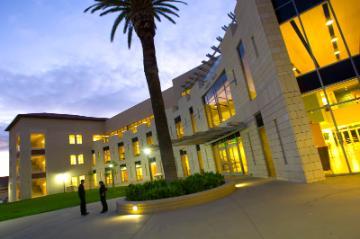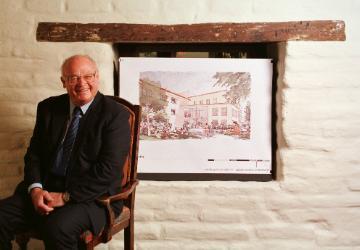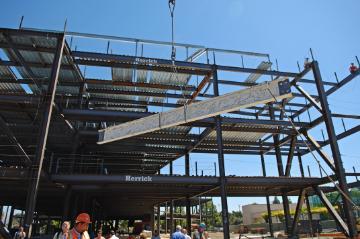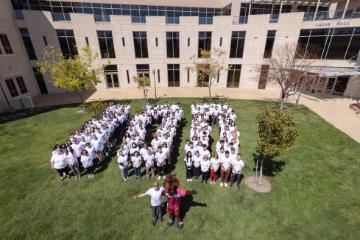
A Legacy of Innovation: Futureproof
Chapter 5: Futureproof (2001–2023)
Each month, Leavey News features a chapter from the centennial book "A Legacy of Innovation." For previous chapters featured in Leavey News, visit our News Room.
Michele Samorani and Haibing Lu were walking back from lunch in 2019 when a chance encounter in Lucas Hall nudged their research in a new direction.

Lucas Hall, the Leavey School of Business’ first new home since Kenna Hall in 1924, opened in 2008.
When fellow Leavey School of Business professor Michael Santoro bumped into the two data scientists, they were clearly excited. They had developed a machine-learning algorithm to optimize medical scheduling. They had a problem, though. In testing the algorithm, Black patients got the least desirable appointment slots with doctors. Bias reared its ugly head in the data set.
That encounter led to a long summer of collaboration. Lead researcher Samorani and Lu explained the data science to Santoro. In turn, the management professor dug into the ethical implications. The result would be an award-winning research paper published just in time for the rise of AI in the public consciousness, a paper that offered solutions, not just problems. It also was the perfect example of why Lucas Hall was planned and built in the first place a decade earlier.
By the 2000s, the Leavey School of Business had all the hallmarks of a successful global business school: A reputation for high-quality teachers and intimate class sizes. Increasingly noteworthy research output. A range of curriculum, from robust undergrad offerings to custom curriculum for companies and advanced learners.
What the school lacked was a unified space. It had long since outgrown its home in Kenna Hall. Posner, dean at the time, said faculty were scattered in several different locations, and often siloed by departments. A school that thrived on interdisciplinary thinking faced physical hurdles to collaboration.
The opportunity to construct a new building offered the solution. In the planning for Lucas Hall, “We consciously decided not to put the faculty together by departments, but to get them to collaborate more,” Posner said.
“To encourage collaboration, the faculty are distributed across two floors of offices so that if I want to get up and talk to one of my management colleagues, I have to get up and go find them. But hopefully on the way I’ll run into some other people to say hello to, people I wouldn’t normally see if they were isolated in their own fiefdoms.”
The distribution of offices has borne fruit. However, faculty togetherness was only one goal of the design of Lucas Hall. Posner said the school also wanted to create a building with “stickiness” to it, meaning that people would stick around after classwork was over. That meant planning for plenty of common spaces and even incorporating food-and-drink options at the Cadence Cyber Cafe. Students, especially working professionals who traveled to campus for coursework, would no longer have to leave the school to get a bite or evening beverage.
Building Relationships
Cadence is one of many names attached to the building that show the school’s long ties to Silicon Valley and the larger business world. A stroll through Lucas Hall shows technology (an in-kind donation), classrooms, conference rooms, lounges, and more sponsored by the likes of Polycom, Forbes, KPMG, Ernst & Young, and more.

Silicon Valley entrepreneur and investor Don Lucas, the namesake for Lucas Hall, was an avid supporter of the Leavey School of Business for decades.
The biggest funding push for the building came from its namesake, Don Lucas, an influential venture capitalist with longstanding ties to both Silicon Valley and the school. According to Mario Belotti, professor emeritus, Lucas’ philanthropy for the school went back decades. Not only had he provided funding for Belotti’s long-running Economics Symposium as early as 1976, but he also had been one of the leaders behind the idea for it.
“They felt that many executives in the area did not know enough economics to understand the potential impact on their firms from national and international economic events,” he wrote in his memoir, It Was All for the Love of a Horse.
Lucas maintained his relationship with the school over the coming decades and was the largest donor for Lucas Hall’s $49 million cost. However, colleagues and acquaintances said Lucas, who died in 2019, always did more than just write a check. He was a true believer and advocate for business education who challenged others to get involved.
“I think he saw the environment that Santa Clara created for business students and then the environment that helped them become business leaders in Silicon Valley,” said Greg Vaughan, managing director and private wealth advisor for Morgan Stanley and one of the many members of the Friends of Don Lucas fundraising group who helped put the building project over the top. “I think he was impressed with the school and always wanted to make it better.”
In turn, Lucas’ enthusiasm rubbed off on others and helped bring even more business leaders into the school’s orbit, whether or not they were graduates. For example, Vaughan has served not only on the school’s advisory board but also as a university regent, and three of his five children are now Santa Clara alumni.

A beam used in the construction of Lucas Hall bears the signatures of many of the key supporters who helped fund the school’s new building.
Ultimately, when Lucas Hall opened in 2008, it was 100 percent privately funded. It provided a modern, centralized 86,000-square-foot home for Leavey’s faculty, students, and staff.
Still, the business world moves quickly, and space needs change. Ed Grier, the current dean, has started the process of reimagining Lucas Hall for a post-COVID world. When Grier came on board in 2021, he took the helm of a school in the midst of a remote reshuffle, much like the entire business world faced at the time. When students, faculty, and staff returned to campus, they faced new realities, from hybrid delivery of education to remote work, which now leads to rethinking physical space.
“I think we can create something that will actually draw people back post Covid in more of a collaboration space,” Grier said in a Q&A for Poets & Quants. “We want cross disciplinary activity. If you’ve been in the marketplace, businesses always tell you now that you’re going to work with different people. The best ideas, the best products, the best outcomes come from cross-functional teams, so we have to create a space for that cross collaboration.”
In other words, the school wants even more moments like that hallway meeting between Samorani, Lu, and Santoro: chance encounters that lead to groundbreaking results.
Ahead of the Curve
Given Santa Clara’s location in the heart of Silicon Valley and the school’s tight connections to industry, a research focus on modern technological and societal problems is hardly surprising.
That was part of the attraction for Esther Sackett, who started at Leavey in 2019. The assistant professor of management — one of Poets & Quants’ Top 50 Undergraduate Business Professors in 2022 — studies collaboration and motivation in teams, an interesting topic in an era when teams and workplaces are changing drastically. For Sackett, bringing approaches from other disciplines, such as anthropology and psychology, into her research is natural. So is melding traditional classroom discussions of what motivates workers with more modern concepts about social justice and diversity, equity, and inclusion. And Leavey provides the foundation for such socially minded, interdisciplinary discussions.
“There’s an emphasis on ethics and understanding different cultures here,” Sackett said of Leavey. “And we have this backdrop of interdisciplinarity that you don’t always get elsewhere.”
Location matters, too.
“Things move wickedly fast in Silicon Valley,” said Tammy Madsen, who teaches MBA, Executive MBA, and Executive Development students and has a particular research interest in practical strategic management. “A lot of new ideas and research opportunities pop up frequently. The beauty of that, from a research and teaching standpoint, is there are many opportunities to connect with executives and companies to discuss and solve problems. Additionally, we want students to think critically, for instance, by motivating them to step back from the latest trend or buzzword and ask: What is the concept, really? What does it mean?”
Case in point: AI. Madsen pointed to a surge in proposals for courses in the topic, not to mention the increase in research on the topic. For instance, with access to Silicon Valley’s advancements, Santoro and company are far from the only researchers tackling AI and machine learning. Sanjiv Das, the William and Janice Terry Professor of Finance and Business Analytics, also studies the topic and does so from a unique location: inside Amazon’s AI and machine learning team.
Das had held faculty appointments at both Harvard and UC Berkeley before coming to Leavey in 2000. In addition to his long and fruitful career, and because of connections he made at Santa Clara, he also has been an Amazon Scholar, with access to Amazon Web Services’ expansive resources, since 2019. One of the first things he did in his multimodal AI research was to look for ways to measure and mitigate bias in data, a concept called “algorithmic fairness” that applies to everything from deciding who gets a loan to who gets parole in a court system.
During Das’ career at Leavey, he has expanded his mathematics repertoire and even attended SCU courses in mathematical physics so he could be better at data science. He has learned new coding languages when the need has arisen. He has been willing to step far outside the typical realm of business, because the research warrants it. In turn, he’s flourished in what he sees as an environment conducive to academic freedom and innovation.
“Some of the research I’ve done here, I’m not sure I could have done anywhere else,” Das said.
Rising to the Challenges
As researchers have responded to the pressing needs of business in the new century, so has Leavey’s curriculum and programming.
Barry Posner’s focus on leadership in the late 1990s and 2000s was timely in the field. It manifested not only in the Executive MBA program, but also in the Leavey Scholars program for students; the Leavey Lecture Series that brought business luminaries to campus to share their perspectives on leadership with students; and ACE (Accelerated Cooperative Education), which provides seminars, internships, and alumni engagement opportunities in an effort to increase the pipeline of high-achieving students entering the business school.
When Drew Starbird became dean in 2010, he was focused on a different business challenge: finding new sources of revenue and niches to serve in a post-recession environment.
“As a result, we added new master’s degree programs other than the MBA, which was a new approach for us,” Starbird said. Leavey’s master’s degree programs in finance and entrepreneurship would launch in the 2010s.

Ed Grier became the school’s first Black dean in 2022, following Caryn Beck-Dudley as the first woman dean in 2015. Julie Sullivan became the first woman and layperson to serve as university president in 2022.
In 2015, Starbird’s successor, Caryn Beck-Dudley, would become the school’s first woman to serve as dean. Beck-Dudley expanded programming in a number of ways, including by redesigning the MBA curriculum, adding more online graduate programs, and launching new master’s degree programs in martech, business analytics, and finance and analytics.
Institutes and centers grew and expanded in the past 10 to 15 years, as well, including the Ciocca Center for Innovation and Entrepreneurship and the rebranded Silicon Valley Executive Center. New initiatives in the DEI world have come on board, too, including the Women’s Corporate Board Readiness and Black Corporate Board Readiness programs. Both are designed to give underrepresented communities better access to training and tools for participating in critical roles on businesses’ boards.
Now, the school enrolls approximately 2,500 students each year. It offers seven business majors and eight minors for undergraduates. It includes an Executive MBA, an evening MBA, an online MBA, and a STEM MBA, fitting for Silicon Valley’s business school. It has in-person and online master’s degree programs in business analytics, finance and analytics, information systems, and marketing.
The school is recognized as the premier school in Silicon Valley for working professionals, with top rankings from U.S News & World Report for the Executive MBA and evening MBA programs. The school boasts a number of programs in the top 25 nationwide, too.
In his 2015 memoir, Belotti noted just how different both the school and community are from when he started there in 1959. A sleepy agricultural valley had become a worldwide hub of industry. The university had grown from educating hundreds yearly to educating thousands. The school’s breadth of programs, initiatives, and centers had been virtually unimaginable decades earlier.
“Two things, however, have not changed: the beauty of the campus and the university’s mission,” Belotti wrote. “Educating students to become good at the jobs they select, and to act honestly and be compassionate with those less fortunate.”
Grier added another enduring trait to that list: serving the business world through innovative scholarship.
“We are squarely focused on helping our Leavey community — students, faculty, and organizations — to address 21st century business challenges, conduct impactful research, and navigate technological advances and key societal issues,” said Grier. “It’s always been part of our history and, I hope, always will be part of our core.”
